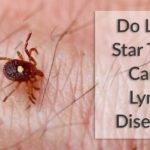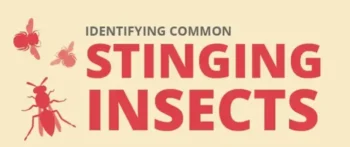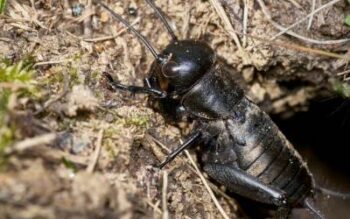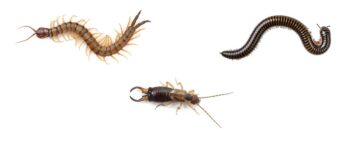
Summer brings hot weather, long days, fun, and insects. Pretty much every Long Island insect species surges in the summertime, but you will see certain ones more often than others.
Mosquitoes
These tiny flying vampires are the bane of outdoor activity. In addition to the itching and aggravation their bites can cause, mosquitoes can carry a host of diseases. Mosquitoes are the most deadly creature on the planet because mosquito-borne diseases kill about one million people a year worldwide.
The most well-known is malaria – which is not a risk on Long Island – but Long Island mosquitoes can carry other diseases like Eastern Equine Encephalitis (EEE), West Nile virus, and others. LI mosquitoes can also technically transmit Zika virus… but the only Zika cases documented here have been traced to travel.
It is not your imagination. Some people are more likely to be bit by mosquitoes than others. Follow some handy tips to avoid mosquito bites.
Wasps
Wasps have a reputation for being very aggressive, but they are mostly aggressive late in the summer season when their food sources diminish… in addition to any stinging insect being aggressive when it feels threatened.
Outdoor parties and activities attract wasps through sweet food and drinks, which they crave. If they do fly near you, back away slowly. Do not swat at them.
Other than that, wasps are a gardener’s helper. They eat other insects that would otherwise decimate plants.
Ticks
While active all year-round, ticks are more active during warm weather. Like mosquitoes, ticks carry diseases. Lyme disease is the best known, but it is not the only one.
In the past, Lyme disease from tick bites mostly occurred after hiking, but ticks have increasingly been found in Long Island backyards. As if their tiny size didn’t already make them difficult to detect, even a dead tick can be harmful if its bite latched onto skin before dying.
Hornets
Members of the wasp family, hornets are extremely dangerous. They can sting more than once and will swarm if they believe their nest is threatened, so experts discourage DIY hornet removal.
While hornets can be dangerous to people; like wasps, they are also beneficial to the environment. Hornets pollinate plants and because they eat flies, beetles, and other garden pests, they help maintain environmental balance.
Carpenter Bees
While Long Islanders think of termites when wood-damaging insects are mentioned, carpenter bees are also a serious threat to homes. They don’t eat wood but rather chew through it to make tunnels for their nests. Because they prefer wood that is soft and unpainted, they often infest window trim, fascia, porch ceilings, and similar wood.
Yellow Jackets
A member of the wasp family, yellow jackets are the bane of outdoor cookouts, drawn by both the protein, which they take back to their colony for larval members, and sugary liquids like soda, melted popsicles, and such.
While their stings are painful, yellow jackets can be a gardener’s helper by eating aphids, flies, crickets, cabbage worms, and beetle grubs, both dead and alive.
Ants
If you find an ant in your home, you might already have a problem. These tiny invaders can enter your home through the smallest cracks and openings. Once one gets in and lays a trail, more will follow.
Removing food sources that attract ants is vital as is keeping essential food tightly sealed in containers ants can’t enter or chew through. Wipe up spills, especially of sticky foods and sweet drinks. If you have a cookout, make sure to clean up thoroughly afterward. For that matter, during the cookout watch out for food and drinks that might be dropped or spilled.
Termites
Homeowners who have experienced a termite swarm probably associate spring with termites. Termites are actually active year-round, but the warm weather of summer is their most active period, which means the time when they’re most likely to be attacking the wood in your home, if it’s been infested.
Keep an eye out for signs of termites like mud tubes, which they use to travel between their colony and your home, which is their feeding ground, bubbled or cracked paint, which can signal wood damage underneath, and hollow sounds when you tap wood.
Silverfish
Long and flat with long antennas and covered with shiny scales, the appearance of silverfish creep some people out – especially since they’re frequently found at night and run away swiftly when the lights are turned on. Silverfish seek warm, moist locations so they are often found around plumbing fixtures, sinks and bathtubs.
Silverfish tend to avoid people, so they are more of an annoyance than a danger if they’re just a brief visitor. However, if undetected silverfish can do significant damage to fabric, wallpaper, books, and paper by chewing or staining it.
Fleas
Like other bugs that can be a year-round problem, flea activity still surges in the summer. Whether taking Fido to the dog park or other outdoor activity, your pet can pick up fleas and – once infested – the fleas can spread to other pets and even you.
While fleas are a terrible nuisance, physically they are fascinating. Did you know that fleas can lift items 150 times heavier than their body weight, and fleas can both jump very high and far… up to 150 times their body length.
Earwigs
While they have a scary reputation because of folk tales that claim they would crawl into people’s ears and attack their brains, earwigs are actually harmless to people. In fact, because they eat other bugs and mold, they can be beneficial.
However, earwigs can also be an annoyance because they can spray a foul-smelling fluid. This same fluid is also released when an earwig is crushed.
Millipedes
Another insect whose unsightly appearance unnerves people, millipedes seek moisture like silverfish and generally live outside. However, they will seek out your home as shelter from weather that’s too hot or too cold as well as excessive rain.
Millipedes are not poisonous… but they do produce hydrochloric acid. That causes a chemical burn when they use it in defensive maneuvers. In addition to the burn, some people have an allergic reaction to the contact.
Arrow Exterminating Can Protect Your Home
Avoid the aggravation and dangers of mosquitoes, wasps, and more by calling Arrow Exterminating. Arrow will help you identify if you have a problem, explain our plan to eradicate your infestation, and give you the peace of mind you need. To get started, contact Arrow Exterminating today.





